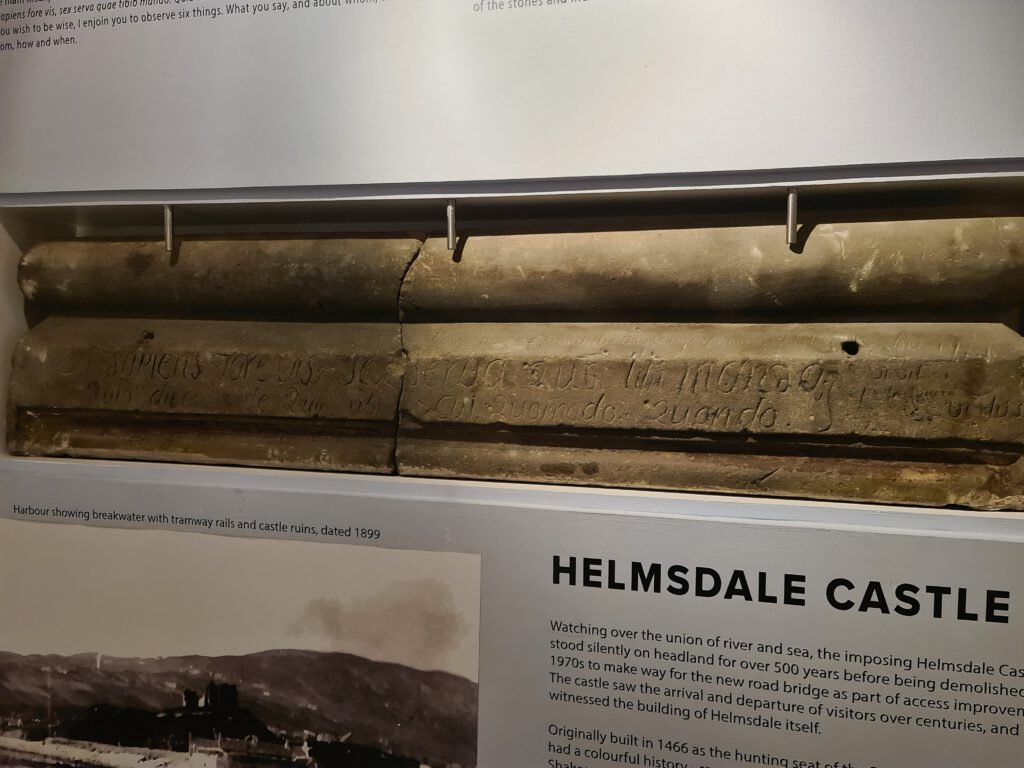Location: Helmsdale Village, Sutherland, Highlands of Scotland
kind of castle: once was a L-plan tower
today: nothing left but one stone next to the A9
public transport: buses and trains from Inverness to Helmsdale
scheduled monument: no
managed by: no one
entrance fee: £ 0
opening times: 24/7
directions: Google Maps

Helmsdale Castle is one that is more often missed than any other castle, mostly due to the fact that it was destroyed a couple of years back to make room for the A9 which surely is a good thing because of the accessibility of the far north, however in my opinion it would have been worth spending a bit more money and instead of taking down the castle simply bypassing it.
The now demolished castle was a 15th century L-plan tower house with a great position. Located at the North Sea coastline and the mouth of the River Helmsdale the former tower was perfectly positioned to protect the land of the Earls of Sutherland.
Belonging to the Earls of Sutherland it was built in 1488 and was the site of the 11th Earl’s poisoning. John, the 11th Earl, and his wife were famously poisoned by his aunt, Isobel Sinclair in 1567, all to make her son the next Earl. However, things went wrong and instead of John’s son, Isobel accidentally poisoned her own son, dying two days later her heir was dead but Alexander, John’s son was still alive. Before being executed in Edinburgh, Isobel killed herself, maybe because of guilt or fear, since the whole plot was most likely hatched by George Sinclair, 4th Earl of Caithness, longing to seize the earldom of Sutherland.

A couple of years later, in 1616 the Gordons of Navidale slightly altered the original castle, after gaining hold of the lands.
There is more to the general history of Helmsdale, the region, the village, rather than the castle ruin itself and the state, the castle was left in, after being pretty much ruined by 1858 led to the demolition in some parts, by the late 1960s a big part of the castles south had been destroyed by erosion, leaving the rest in danger of collapse. So, it is no wonder that when the A9 was to get a new bridge in the 1970s, the castle was to be taken down only leaving a stone in the car park next to the A9 to commemorate the former stronghold.
With evidence dating back as far as a Viking settlement, the history of Helmsdale is a very long one, although what can be seen today dates to more recent times. The local area played a central role in the Highland Clearances, some of the most notorious clearances in all of Scotland, by the first Duke of Sutherland.

From 1814 a planned village was created, laid out on a grid pattern by the Sutherland Estates, this was the case so that not everyone affected by the clearances, happening further inland, had to be shipped to the colonies or USA.
This created a community, able to live from fishing and farming. Helmsdale then had the largest herring fleet in all of Europe. Along with the fish came the gold rush of 1869, mainly located in the Strath of Kildonan rather than Helmsdale castle or Helmsdale village. These days you can find information about the local history, especially regarding the gold rush and the Highland clearances the exhibitions are interesting.
Although there is nothing of the castle left now, it is said that the grim history of it inspired William Shakespeare’s Hamlet. It is sad that the castle ruin is lost but it is good that at least some parts of its history are still remembered. With the castle being gone I can only advise you to still not skip Helmsdale as a location to visit but spend some time there, I spend a couple of days there and enjoyed the lovely are quite a lot, so you can be capable of the same.


Pingback: Dunrobin Castle – A scottish World